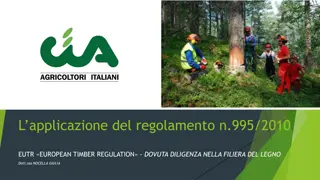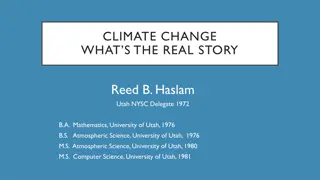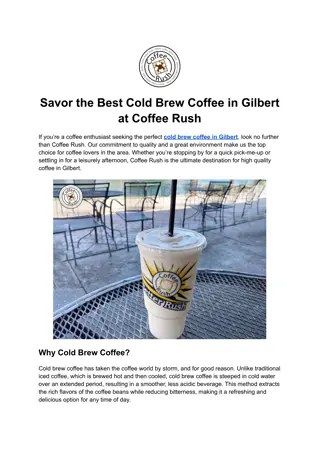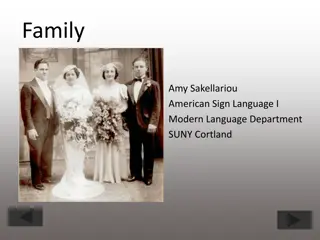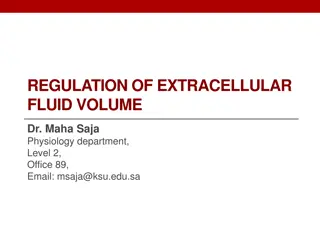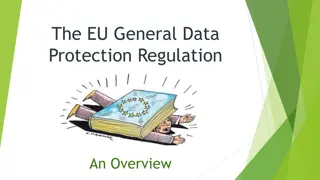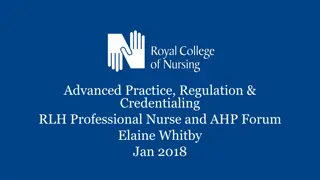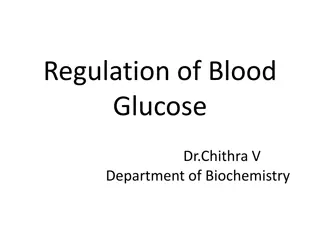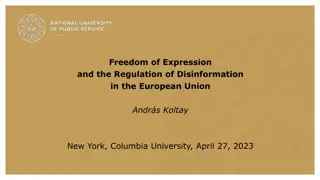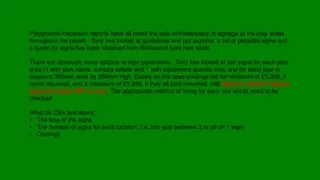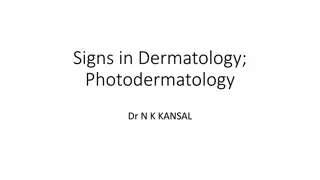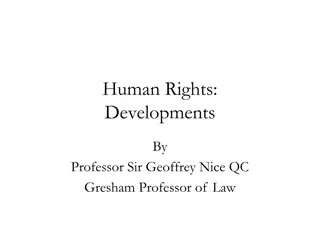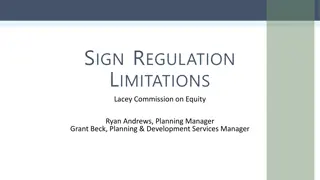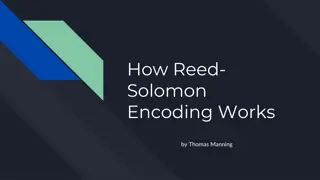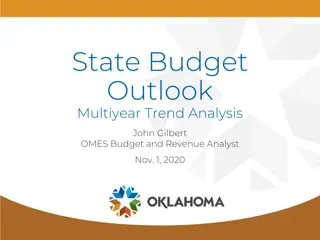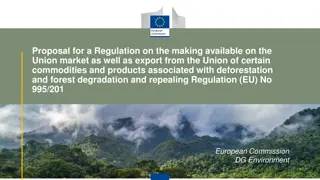Sign Regulation after Reed v. Gilbert
This content delves into the implications of the Reed v. Town of Gilbert case on sign regulations. It covers key areas of sign regulation, the parties involved, sign size limits, and duration periods in Gilbert, AZ. The case revolved around a homeless church's directional signs and political signage, challenging the town's regulations.
Download Presentation

Please find below an Image/Link to download the presentation.
The content on the website is provided AS IS for your information and personal use only. It may not be sold, licensed, or shared on other websites without obtaining consent from the author.If you encounter any issues during the download, it is possible that the publisher has removed the file from their server.
You are allowed to download the files provided on this website for personal or commercial use, subject to the condition that they are used lawfully. All files are the property of their respective owners.
The content on the website is provided AS IS for your information and personal use only. It may not be sold, licensed, or shared on other websites without obtaining consent from the author.
E N D
Presentation Transcript
http://www.wsh-law.com/images/logo.jpg Sign Regulation after Reed v. Gilbert Susan L. Trevarthen, FAICP Member, Weiss Serota Helfman Cole & Bierman,P.L. Fort Lauderdale, FL John M. Baker Founding Partner, Greene Espel PLLP Minneapolis, MN APA National Planning Conference - May 7, 2017
Sign Regulation after Reed v. Town of Gilbert Overview: Reed v. Town of Gilbert a brief synopsis Implications of Reed for five key areas of sign regulation Reed in the lower courts, and prospects for future developments of sign law Issues in sign law following Reed Questions and answers
Reed v. Town of Gilbert a brief synopsis Before Reed, conflicting tests for whether a law was content-neutral The flexible test: Ward v. Rock Against Racism a law is content neutral unless - It restricts speech because of the ideas it conveyed; or It restricts speech because the government disapproves the message. The harsh test: a literal interpretation of Mosley a law is content neutral unless You need to read the sign in order to determine whether it violates that law
Reed v. Town of Gilbert a brief synopsis The parties: Plaintiffs were a small homeless church its pastor, and its members They used temporary directional signs to guide people to their services Town of Gilbert is a suburb of Phoenix, with a population exceeding 200,000
Reed v. Town of Gilbert a brief synopsis Plaintiffs Candidates political signs qualifying event signs
Maximum sign sizes in Town of Gilbert Homeowners Assn signs (80 sq. ft.) Political signs (nonresidential zone) (32 sq. ft.) Ideological signs (20 sq. ft.) Qualifying Event signs (6. sq. ft.)
Maximum Duration Periods in Town of Gilbert Nonpolitical, non-ideological, non-commercial qualifying event signs: Allowed up to 12 hours before and one hour after the event Political temporary signs: Allowed up to 60 days before and 15 days after elections
Reed v. Town of Gilbert: The Outcome All nine justices agreed that the Ninth Circuit should not have ruled in the Town s favor, but did not all agree on a rationale for that result. Four opinions were issued: Majority opinion (Justice Clarence Thomas, joined by five others) One concurrence (Justice Samuel Alito, joined by two others) Two concurrences in the judgment (Justice Stephen Breyer, Justice Elena Kagan, joined by Justice Ruth Ginsburg)
MAJORITY OPINION Government regulation of speech is content based if a law applies to particular speech because of the topic discussed or the idea or message expressed.
MAJORITY OPINION Even a purely directional message, which merely gives the time and location of a specific event, is one that conveys an idea about a specific event.
MAJORITY OPINION If a sign regulation, on its face, is content-based, its purpose does not matter.
MAJORITY OPINION The purpose-based Ward test cannot save a law that, on its face, is content- based. The Ward test is just an alternative way to prove that a law is content- based.
THE CONCURRENCE OF J. ALITO (+2) I join the opinion of the Court but add a few words of further explanation. Justices Kennedy and Sotomayor joined his concurrence
THE CONCURRENCE OF J. ALITO (+2) I will not attempt to provide anything like a comprehensive list, but here are some rules that would not be content-based
THE CONCURRENCE OF J. ALITO (+2) His list included: Rules regulating size based on any content-neutral criteria, Rules regulating the locations in which signs may be placed Rules distinguishing between placement of signs on public and private property and commercial and residential property on-premises and off-premises signs
Implications of Reed for: Commercial speech doctrine and regulation of commercial signs Regulation or prohibition of off-premises signs Regulation by zoning district Regulation of Illumination, size and form Importance of legislative findings
WARNING Reed requires a change of mindset in drafting. Safe methods of regulation can still result in problems if you layer content-based definitions and regulations on top of them. Still have to watch for the old issues content neutrality satisfying intermediate scrutiny discretionary standards loose timeframes for approval
Commercial Speech Doctrine And The Regulation Of Commercial Signs Reed: At oral argument, Reed s attorney specifically distinguished the rule he proposed from the rule that would apply to commercial speech, and acknowledged that the Court s jurisprudence allowed regulations on commercial speech to be treated differently. Lamar Cent. Outdoor, LLC v. City of Los Angeles, 245 Cal. App. 4th 610, 625, 199 Cal. Rptr. 3d 620, 630 31 (2016), reh'g denied, (Mar. 29, 2016), rev. denied (June 8, 2016) (rejecting a facial challenge to the city s stricter regulation of billboards over on-premise signage
Commercial Speech Doctrine And The Regulation Of Commercial Signs Reed is of no help to plaintiff either. Like Sorrell, it does not purport to eliminate the distinction between commercial and noncommercial speech. It does not involve commercial speech, and does not even mention Central Hudson. Reed required strict scrutiny of a sign ordinance that was content-based on its face, treating various kinds of noncommercial signs differently depending on their subject matter. [citation omitted] Reed did not cite Metromedia II either, so Reed certainly did not overrule or disapprove that precedent. Indeed, as we have seen, three of the justices joining the court's opinion in Reed expressed the view that onsite-offsite distinctions and distinctions between placement of signs on private and public property are not content-based and do not require strict scrutiny.
Commercial Speech Doctrine And The Regulation Of Commercial Signs Lone Star Sec. & Video, Inc. v. City of Los Angeles, 827 F.3d 1192, 1198 n.3 (9th Cir. July 7, 2016)( although laws that restrict only commercial speech are content based, see Reed III, 135 S.Ct. at 2232, such restrictions need only withstand intermediate scrutiny, citing Central Hudson). Peterson v. Vill. of Downers Grove, 150 F. Supp. 3d 910, 928 (N.D. Ill. Dec. 14, 2015) (on appeal) ( What is important for this case [involving regulation of a business s painted wall signs] is that, absent an express overruling of Central Hudson, which most certainly did not happen in Reed, lower courts must consider Central Hudson and its progeny which are directly applicable to the commercial-based distinctions at issue in this case binding. ) Supreme Court has held that cities cannot arbitrarily prohibit commercial speech while permitting noncommercial speech where the effects of both types are identical: City of Cincinnati v. Discovery Network, Inc., 507 U.S. 410, 425 (1993) (newsracks; sufficiency of record)
Regulation or Prohibition of Off-Premises Signs Reed: Alito blesses this. Metromedia: 7 justices explicitly concluded that cities could prohibit billboards, and most indicated that cities could do so without also banning on-premise commercial signs. Thus, offsite commercial billboards may be prohibited while onsite commercial billboards [signs] are permitted, a wholly impartial ban on billboards would be permissible, a legislative body can reasonably conclude that every large billboard adversely affects the environment, for each destroys a unique perspective on the landscape and adds to the visual pollution of the city, In my view, aesthetic justification alone is sufficient to sustain a total prohibition of billboards within a community, If a precedent of [the] Court has direct application in a case, yet appears to rest on reasons rejected in some other line of decisions, lower courts should follow the case which directly controls, leaving to [the Supreme] Court the prerogative of overruling its own decisions. Agostini v. Felton, 521 U.S. 203, 237 (1997).
Regulation By Zoning District Acceptable even under Thomas opinion As more communities move away from zoning districts, they lose a clearly justifiable basis for distinguishing sign control Form-based categories or transects should logically fall under the same analysis Regulation by corridors Regulation by special area plans
Regulation By Illumination, Size and Form Acceptable even under Thomas opinion Scenic America challenge to US FHWA guidance authorizing digital billboards Government prevailed in the DC Circuit Court of Appeals; petition for certiorari filed in US Supreme Court
Importance of Legislative Findings If truly strict scrutiny, need to show a record establishing that compelling governmental interests justify the regulation Compelling interests: Traffic safety State constitutional provisions? State-mandated comprehensive planning and regulation of development and signs? Reliance on caselaw and foreign studies
Reed in the lower courts What we have learned from subsequent decisions construing Reed Prospects for future development of sign law Status of Highway Beautification Act, and related state statutes
Reed in the lower courts Are lower courts now striking down regulations that define regulated speech by its function or purpose, based on an extraneous, unnecessary sentence in the majority opinion? Not the Ninth Circuit. In Lone Star Sec. & Video, Inc. v. City of Los Angeles last year, it upheld local restrictions on mobile billboards. It explained that an officer seeking to enforce the non-motorized billboard ordinances must decide only whether an offending vehicle constitutes a prohibited advertising display because its primary purpose is to display messages, as opposed to transporting passengers or carrying cargo.
Reed in the lower courts Are lower courts interpreting the majority opinion s silence regarding sexually- explicit entertainment, as extending the harsh standard for content-neutrality to regulation of sexually-oriented businesses, too? The decisions have been few, and somewhat mixed. The Seventh Circuit: We don't think Reed upends established doctrine for evaluating regulation of businesses that offer sexually explicit entertainment, a category the Court has said occupies the outer fringes of First Amendment protection. The Third Circuit: Reed is applicable to a suit involving explicitly sexual entertainment; any application of the secondary effects doctrine beyond what the Supreme Court has explicitly endorsed would bring this case into direct conflict with Reed s pronouncement that we cannot look behind a facially content-based law to a benign motive .
Reed in the lower courts Are lower courts interpreting the majority opinion s silence regarding sexually- explicit entertainment, as extending the harsh standard for content-neutrality to regulation of sexually-oriented businesses, too? The decisions have been few, and somewhat mixed. The Seventh Circuit: We don't think Reed upends established doctrine for evaluating regulation of businesses that offer sexually explicit entertainment, a category the Court has said occupies the outer fringes of First Amendment protection. The Third Circuit: Reed is applicable to a suit involving explicitly sexual entertainment; any application of the secondary effects doctrine beyond what the Supreme Court has explicitly endorsed would bring this case into direct conflict with Reed s pronouncement that we cannot look behind a facially content-based law to a benign motive .
Prospects for Future Developments in Sign Law Following Reed Continued validity of prior sign caselaw per Agostino Off-premise/on-premise: Alito in Reed, Metromedia Must provide for real estate signs: Linmark Commercial speech: Central Hudson Reed limited to its scope: differential treatment of non-commercial speech Continuing impacts outside of sign law e.g., solicitation regulations
Status of Highway Beautification Act and State HBAs Following Reed 1965 Highway Beautification Act, 23 U.S.C. 131, establishes a grant-in-aid condition with which States must comply in order to receive full federal highway funding. Under the HBA, the size, lighting and spacing of billboards along federal highways are governed by agreements negotiated between the individual States and the Secretary of Transportation. Standards must be consistent with customary use, and maintain effective control of outdoor advertising. HBA: allowing off-premise signs is consistent with effective control when (1) they are located in commercial or industrial areas, and (2) their size, lighting and spacing accords with the terms of the applicable federal-state agreement Alito concurrence in Reed specifically blesses the onsite/offsite distinction
Status of Highway Beautification Act and State HBAs Following Reed Auspro Enterprises, LP v. Texas Dep't of Transp., No. 03-14-00375-CV, 2016 WL 7187475 , at *6 (Tex. App. Dec. 8, 2016) (on rehearing, leaving the Texas Highway Beautification Act s regulation of off-premises signage in place because our decision here is necessarily limited to government regulation of noncommercial speech ; prior opinion treated on-premise exemption as content-based under Reed s framework) Thomas v. Schroer, 116 F. Supp. 3d 869, 876 (W.D.Tenn. June 24, 2015) (granting the plaintiff's temporary restraining order because town's on-site/off-site distinction regulating noncommercial speech was likely content-based and subject to strict scrutiny under Reed); 127 F. Supp. 3d 864, 873 (W.D. Tenn. Sept. 8, 2015) (granting preliminary injunction based on the same interpretation of Reed). In September 2016, at the end of a trial on strict scrutiny, a jury returned a verdict in favor of defendants. Plaintiff then urged the district court judge to issue an independent determination reaching the opposite conclusion. In March 2017, the judge reversed the jury. An appeal is expected.
Issues in Sign Regulation following Reed Government Speech and other issues with the scope of sign regulations Temporary signs Issues in definitions, prohibited signs, and signs exempt from permitting, including directional and identification signs Regulation by land use Master sign plans, sign design standards, and review processes
Government Speech and Other Issues with the Scope of Sign Regulations Governments do not have First Amendment rights. Control over the use of government property is an exercise of proprietary power rather than regulatory power. While a government can hold itself to a standard, that standard cannot be challenged under the First Amendment. While governments cannot use these powers to retaliate/discriminate against a person s First Amendment rights, they generally have broad discretion to do as they see fit. Implication: Sign codes should be strictly defined to apply to private speech on private property Governments should not allow private speech of any kind to be placed on public property if anything is allowed, then everything is allowed via substitution Common categories: Signs at public facilities like community centers Traffic control devices Special event signs for a governmentally sponsored event
Temporary signs after Reed Distinguishing between temporary and permanent signage is not content discrimination, even after Reed As noted above, Reed did not involve commercial signage (the most common form of temporary signage) However, Reed indirectly adds pitfalls to communities that try to strike a balance regarding temporary noncommercial signage Why: content-neutrality is more apt to be violated by the use of descriptive exceptions to general prohibitions, than by either blanket prohibitions or general deregulation of temporary signs. Communities have traditionally exempted temporary signs from general prohibitions for a period specified before, and shorter time after, the event depicted on the sign.
Temporary signs after Reed The quandary after Reed with permission for temporary signage based on the date of the event:
Temporary signs after Reed Alternative approaches that avoid Reed s content-discrimination test Define the permissible period based on an external event. Example: Oregon League of Cities ( OLC ) election sign provision: permitting additional signs during the period from 120 days before a public election or the time the election is called, whichever is earlier, to five days after the public election. OLC charitable fundraising event sign provision: permitting additional signs during the period of charitable fundraising event being conducted on the property . . . . The sign shall not be placed more than 7 days prior to the event and must be removed within 2 days following the event.
Temporary signs after Reed Alternative approaches that avoid Reed s content-discrimination test Define the permissible period based on the date a temp sign permit is issued. For example, a city could create a simple permit program for temporary signage. A resident (with an upcoming graduation party) could complete a web- based form for a one-week sign permit, indicating the preferred date of issuance With the permit would be a city-generated sticker, indicating the 7thday after the date of issuance, to be placed on the back of the sign The sign would be legal until the date on the sticker has passed.
Temporary signs after Reed If your community decides to respond to the added difficulty of maintaining content-neutral exemptions to a general prohibition on temporary signs, de- regulate temporary commercial signage with caution. Before (and after) Reed, commercial speech cannot be favored over noncommercial speech. Therefore, if a community chooses to open the door for greater temporary commercial signage (such as real estate open house signs which are not required by Linmark), then to avoid giving favoritism for commercial over noncommercial speech it must open the door at least as wide for greater noncommercial signage, too.
Issues in Definitions, Prohibited Signs, and Signs Exempt from Permitting, Including Directional and Identification Signs After Reed, a community is more likely to get into trouble by drawing fine distinctions between types of signs in its sign code, than by simplifying their sign code. Therefore: Reduce the number of exceptions to permitting requirements, wherever possible. Do not introduce exceptions in the prohibited sign list. Reduce the number of sign categories. Consider both deregulation of some categories of signage, AND a flat ban on categories of signage Both extremes are more likely to withstand constitutional scrutiny after Reed than a nuanced regulatory scheme with a different regulation for each type of sign This means that a content neutral sign code does not necessarily mean a more permissive sign code.
Issues in Definitions, Prohibited Signs, and Signs Exempt from Permitting, including Directional and Identification Signs Problem: content-neutral exceptions for identification signs and drive through -> signs Concrete solution: exempt signs based on activity on the site, not sign content Before Reed: an exemption allowing identification signs After Reed: an exemption allowing a sign that is defined to serve the purpose of identifying a property Before Reed: an exemption for drive-in directional sign After Reed: exemptions allowing an extra sign (<10 sq. ft., < 48 inches in height, and <six feet from a curb cut), for a lot that includes a drive-through window Strict scrutiny? Unclear. Suggestion: An ambulance finding a location quickly in order to help a person having a stroke is a compelling public safety interest.
Issues in Definitions, Prohibited Signs, and Signs Exempt from Permitting, including Directional and Identification Signs Problem: how should a community legalize address signs? Concrete solution: exempt an extra sign, of that size and location Every parcel shall be entitled to one sign <36 sq. inches in surface area to be placed in any of the following locations: On the front of every building, residence, or structure; On each side of an authorized United States Postal Service mailbox; On one post which measures no more than 48 inches in height and 4 inches in width. Treat as compelled speech?
Regulation by Land Use Examples: Sign Regulations for Stadiums, Gas Stations, Theme Parks, Multi-Tenant Centers Different From Regulating by Zoning District Speaker-Based Regulation? Per Thomas Opinion, Not Automatically Invalid: Because "[s]peech restrictions based on the identity of the speaker are all too often simply a means to control content," Citizens United v. Federal Election Comm'n, . . . we have insisted that "laws favoring some speakers over others demand strict scrutiny when the legislature's speaker preference reflects a content preference," Turner, 512 U.S., at 658, 114 S.Ct. 2445. See also Sorrell v. IMS Health Inc., 564 US 552 (2011) Compare Gresham v. Picker, No. 2:16-cv-01848-JAM-CKD (E.D.Ca. Oct. 6, 2016) California law prohibiting political consulting firm from making automated electoral calls (but allowing robo-calls from police to inform the public about dangerous conditions or from schools to provide information to parents) was not an impermissible content-based regulation because the exceptions to the robo- call statute were based on the relationship between caller and recipient, not on the call's content.
Master Sign Plan, Sign Design Standards, and Review Processes Thomas and Alito both allow for regulation of the size, shape, location, illumination, and other physical attributes of signs, so long as distinctions are not drawn on content Advantage of master sign plan usually approved at time of site plan, before anyone is seeking a sign permit and is unrelated to particular message. Can incorporate into overall aesthetic review, and need not worry about prior restraint timeframes. Businesses may assert protection under Lanham Act, but it is limited to the actual registered mark and not associated attributes. Cannot require alteration of a mark. Minimize discretionary aesthetic review at the time of sign permit, when prior restraint must be satisfied



